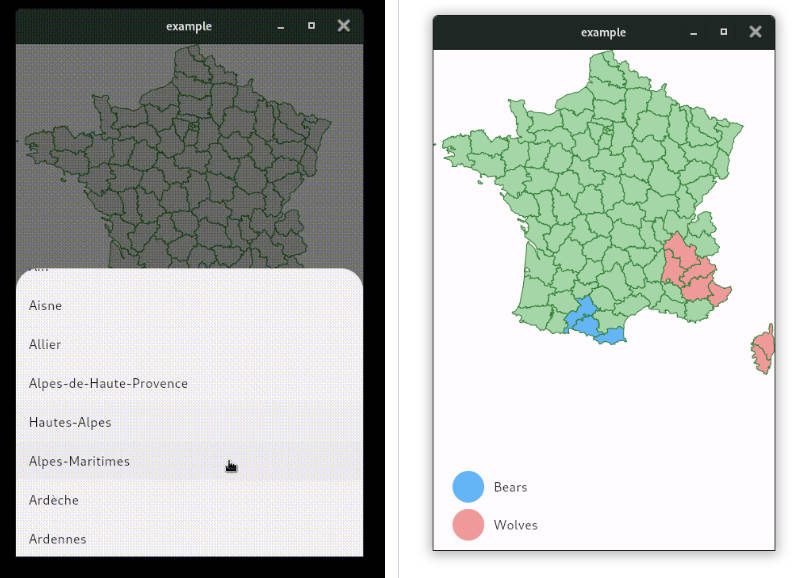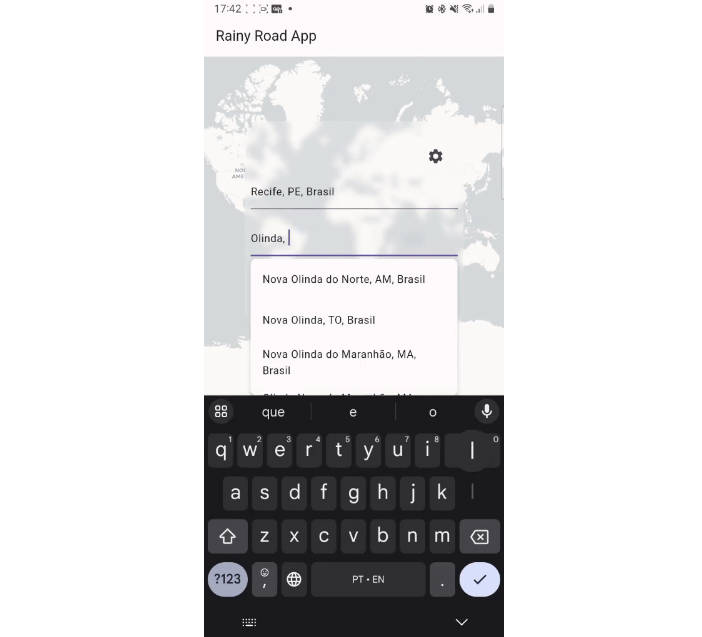geojson_vector_slicer
A flutter_map plugin to display fast geojson by slicing into tiles. Slicing based off https://github.com/mapbox/geojson-vt
IMPORTANT! This is an alpha/proof of concept version currently.
Getting Started
See the example main.dart, will create specific examples later.
Main features:
-
Display GeoJSON by splitting them into tiles (tiles are stored in an Index).
-
Line simplification on GeoJSON.
-
Polyline/polygon tap/hit detection code.
-
Can Display Vector tiles (no mapbox styling works on this or is intended to).
-
Can cluster markers (basic) based on tiles (no spiderfy features).
How it works
Tiles belong to an Index we create at first.
geoJsonIndex = await geoJSON.createIndex('assets/ids.json', tileSize: tileSize);
This creates an index, precalculates zoom 0-2 for performance (higher zooms are calculated on the fly)
Tile Index Options
{
'maxZoom': 14, // max zoom to preserve detail on
'indexMaxZoom': 5, // max zoom in the tile index
'indexMaxPoints': 100000, // max number of points per tile in the tile index
'tolerance': 3, // simplification tolerance (higher means simpler)
'extent': 4096, // tile extent
'buffer': 64, // tile buffer on each side
'lineMetrics': false, // whether to calculate line metrics
'promoteId': null, // name of a feature property to be promoted to feature.id
'generateId': false, // whether to generate feature ids. Cannot be used with promoteId
'debug': 2 // logging level (0, 1 or 2)
};
GeoJsonWidget options
index: Our index we created earlier.
options: our GeoJSONOptions (see below)
drawClusters: true to erm draw clusters instead of raw features.
drawFeatures: true to erm draw the features
(You probably only want one of these enabled, but you can have both enabled for testing).
featuresHaveSameStyle: true if all geometry has the same color. This may give a performance tweak as we can batch draw calls up
Available GeoJSONOptions are:
Function? lineStringFunc;
Function? lineStringStyle;
Function? polygonFunc; // callback for polys
Function? polygonStyle; // styling for polys
Function? pointFunc; // marker/points, draw to canvas
Function? pointWidgetFunc; // marker/points, show a widget
Function? pointStyle; // marker/points styling
Function? overallStyleFunc; // one overall callback for a feature
Function? clusterFunc; // call this if we're displaying a cluster
bool featuresHaveSameStyle; // performance improvement (maybe) if all features are the same
Example Widget
GeoJSONWidget(
drawClusters: true,
drawFeatures: false,
index: geoJsonIndex,
options: GeoJSONOptions(
featuresHaveSameStyle: false,
overallStyleFunc: (TileFeature feature) {
var paint = Paint()
..style = PaintingStyle.stroke
..color = Colors.blue
..strokeWidth = 5
..isAntiAlias = false;
if(feature.type == 3) { // lineString
///paint.style = PaintingStyle.fill;
}
return paint;
},
pointWidgetFunc: (TileFeature feature) {
//return const Text("Point!", style: TextStyle(fontSize: 10));
return const Icon(Icons.airplanemode_on);
},
pointStyle: (TileFeature feature) { return Paint(); },
pointFunc: (TileFeature feature, Canvas canvas) {
if(CustomImages.imageLoaded) {
canvas.drawImage(CustomImages.plane, const Offset(0.0, 0.0), Paint());
}
},
///clusterFunc: () { return Text("Cluster"); },
///lineStringFunc: () { if(CustomImages.imageLoaded) return CustomImages.plane;}
polygonFunc: null,
polygonStyle: (feature) {
var paint = Paint()
..style = PaintingStyle.fill
..color = Colors.red
..strokeWidth = 5
..isAntiAlias = false;
if(feature.tags != null && "${feature.tags['NAME']}_${feature.tags['COUNTY']}" == featureSelected) {
return paint;
}
paint.color = Colors.lightBlueAccent;
return paint;
}
),
Example Vector Tile Widget
VectorTileWidgetStream(size: 256.0, index: vectorTileIndex,
options: const {
'urlTemplate': 'https://api.mapbox.com/v4/mapbox.mapbox-streets-v8/{z}/{x}/{y}.mvt?mapbox://styles/<name>/<key/',
'subdomains': ['a', 'b', 'c']},
),
onTap for polygons
onTap: (tapPosition, point) {
featureSelected = null;
// figure which tile we're on, then grab that tiles features to loop through
// to find which feature the tap was on. Zoom 14 is kinda arbitrary here
var pt = const Epsg3857().latLngToPoint(point, mapController.zoom.floorToDouble());
var x = (pt.x / tileSize).floor();
var y = (pt.y / tileSize).floor();
var tile = geoJsonIndex.getTile(mapController.zoom.floor(), x, y);
if(tile != null) {
for (var feature in tile.features) {
var polygonList = feature.geometry;
if (feature.type != 1) {
if(geoJSON.isGeoPointInPoly(pt, polygonList, size: tileSize)) {
infoText = "${feature.tags['NAME']}, ${feature.tags['NAME']} tapped";
if(feature.tags.containsKey('NAME')) {
featureSelected = "${feature.tags['NAME']}_${feature.tags['COUNTY']}";
}
}
}
}
if(featureSelected != null) {
print("Tapped $infoText $featureSelected");
}
}
setState(() {});
},



